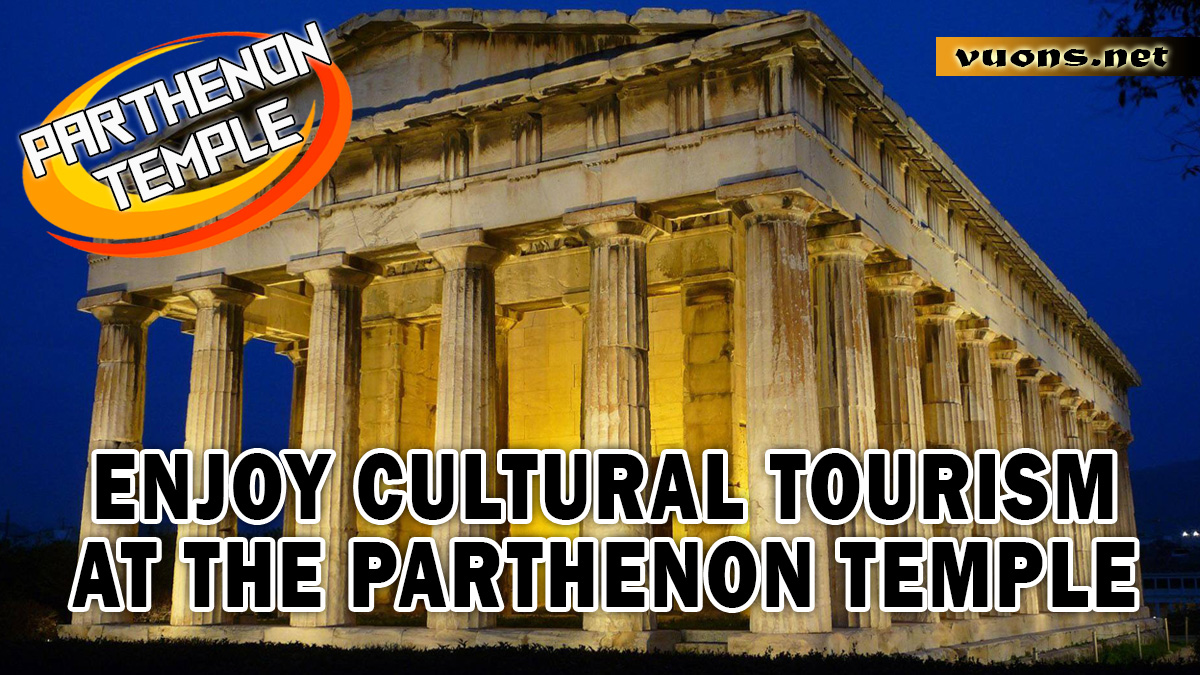Enjoy Cultural Tourism at the Parthenon Temple
A Brief History of the Parthenon Temple: Icon of Athens’ Glory
The Parthenon Temple is one of the most famous architectural Masterpieces in the world, built in the 5th century BC at the top of the Acropolis, Athens. The temple was dedicated to the city’s patron goddess, Athena Parthenos, who symbolized strength and wisdom. The Parthenon was built during Athens’ heyday under Pericles, as a symbol of victory after the Greco-Persian Wars.
The main architects behind the Parthenon were Ictinus and Callicrates, while the magnificent statue of Athena within the temple was designed by the famous sculptor, Phidias. This temple was built using white marble from Mount Pentelicus, giving it a majestic impression that has lasted for thousands of years. The uniqueness of the Parthenon’s architecture can be seen from the use of the Doric style with distinctive elements, such as large columns and metope carvings depicting mythological scenes.
Apart from being a place of worship, the Parthenon also functions as a center for social and cultural activities. The carved friezes surrounding the temple depict the Panathenaic procession, Athens’ largest annual festival in honor of the Goddess Athena. This shows how important the Parthenon was to ancient Athenian society, not only religiously, but also as a symbol of national unity and identity.
Over the centuries, the Parthenon Temple underwent various changes in function, from a Christian church to a mosque during the era of the Ottoman Empire. Despite damage from war and theft, the Parthenon remains one of the most influential historical sites in the world. Today, the Parthenon is recognized as a UNESCO World Heritage Site and is a cultural tourism magnet for millions of visitors every year who want to experience the grandeur of ancient Greek civilization.
The Magnificent Architecture of the Parthenon Temple: An Enduring Wonder
The Parthenon Temple in Athens is one of the finest examples of ancient Greek architecture that remains stunning to this day. Built between 447 and 432 BC, the Parthenon was designed by architects Ictinus and Callicrates with supervision from the famous sculptor, Phidias. The temple uses the Doric architectural style, characterized by simple but elegant large columns.
One of the unique architectural features of the Parthenon is its perfect symmetrical proportions. The architects used mathematical principles to ensure each element was balanced, creating an optical illusion that makes the building look straight and solid from any angle. For example, the columns are curved slightly inward to compensate for natural optical distortions that occur at certain viewing distances.
The Parthenon Temple is also decorated with stunning decorations, especially on the metopes and friezes. Reliefs on the metope depict legendary battle scenes, including a war between humans and centaurs, while the frieze encircling the top of the temple depicts the Panathenaic procession, an annual festival celebrating the Goddess Athena.
The white marble used in the construction of the Parthenon was taken from Mount Pentelicus, which not only gives it a beautiful shine, but also extraordinary durability. Although it has suffered damage from war, theft and weather over the centuries, the structure of the Parthenon has largely survived.
The Parthenon’s architecture combines elements of aesthetic beauty and engineering sophistication, making it a masterpiece that continues to inspire today. This building is not only a symbol of the glory of ancient Greece, but also a testament to extraordinary craftsmanship in design and construction.
Greek Mythology Behind the Construction of the Parthenon Temple
The construction of the Parthenon Temple in Athens not only reflects the beauty of ancient Greek architecture, but is also closely related to Greek mythology. This temple was dedicated to Athena Parthenos, the patron goddess of the city of Athens, who was considered a symbol of wisdom, courage and war strategy. The erection of the Parthenon confirmed Athena’s victory over Poseidon in the struggle for protection of the city.
According to mythology, Poseidon and Athena competed to become Athena’s protector. Poseidon offered a sea spring as a gift, but the water was salty and of little use to the people. Meanwhile, Athena gave him an olive tree, a symbol of peace and prosperity. The council of gods and citizens of Athens finally chose Athena as their protector, and as a tribute, the Parthenon Temple was built on the Acropolis.
The temple is also decorated with carvings and reliefs depicting various mythological scenes. One of the most prominent is a metope depicting a battle between humans and centaurs, symbolizing the struggle between the forces of good and evil. Additionally, the frieze surrounding the top of the temple depicts the Panathenaic procession, a festival held in honor of Athena.
The statue of Athena Parthenos that once stood majestically in the temple was designed by Phidias, a famous sculptor of his time. The statue, made of gold and ivory, depicts Athena in battle attire, complete with spear and shield, emphasizing her important role in mythology and the lives of Athenian citizens.
Through the presence of the Parthenon Temple, Greek mythology is not only commemorated but also immortalized in one of the most magnificent monuments in the history of human civilization.
Parthenon Temple Restoration: Efforts to Preserve World Heritage
The restoration of the Parthenon Temple in Athens has been an ongoing project since the 19th century, with the aim of preserving this architectural wonder for future generations to enjoy. This temple, built in the 5th century BC, suffered major damage due to war, theft and natural erosion. One of the greatest damages occurred in 1687 when a huge explosion hit the Parthenon during the Ottoman siege, damaging much of the original structure.
Modern restoration efforts began in the early 19th century when archaeologists and engineers began documenting the condition of the building and restoring damaged elements. In the 20th century, the Greek government together with UNESCO began a massive restoration project, using advanced technology to ensure the accuracy of the reconstruction. Experts utilized real marble from Mount Pentelicus, the same source material used to build the Parthenon thousands of years earlier.
One of the main challenges in the restoration process is recovering missing or badly damaged parts without changing the original integrity of the building. Several important carvings and statues, including the Elgin marbles housed in the British Museum, have been the subject of international controversy over attempts to return them to Greece.
The restoration of the Parthenon Temple was not only about restoring its visual beauty, but also protecting an important symbol of Ancient Greek civilization. The project involves a multidisciplinary team, including archaeologists, engineers and conservators, working together to restore one of the world’s most iconic heritage sites. To this day, restoration efforts continue, indicating a global commitment to preserving the Parthenon as a witness to the history and cultural heritage of mankind.




